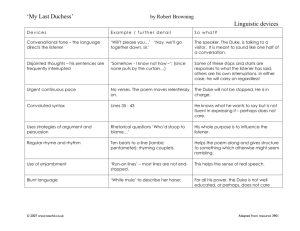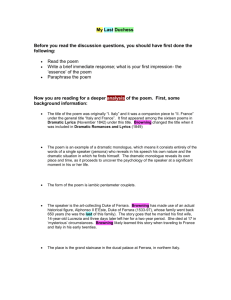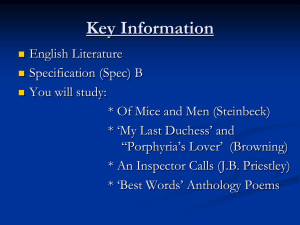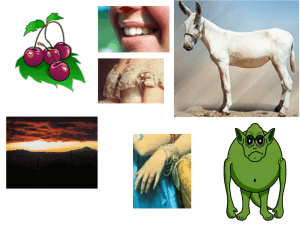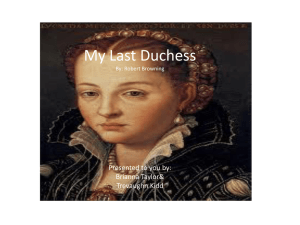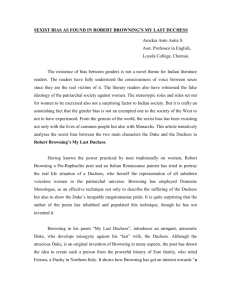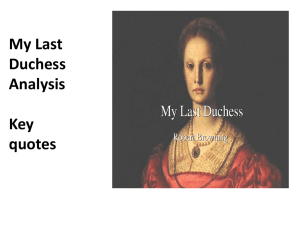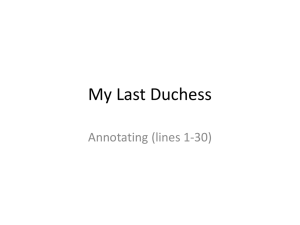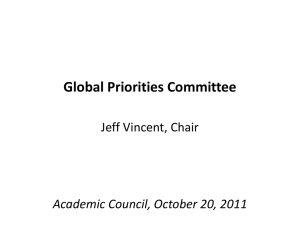My Last Duchess 2
advertisement
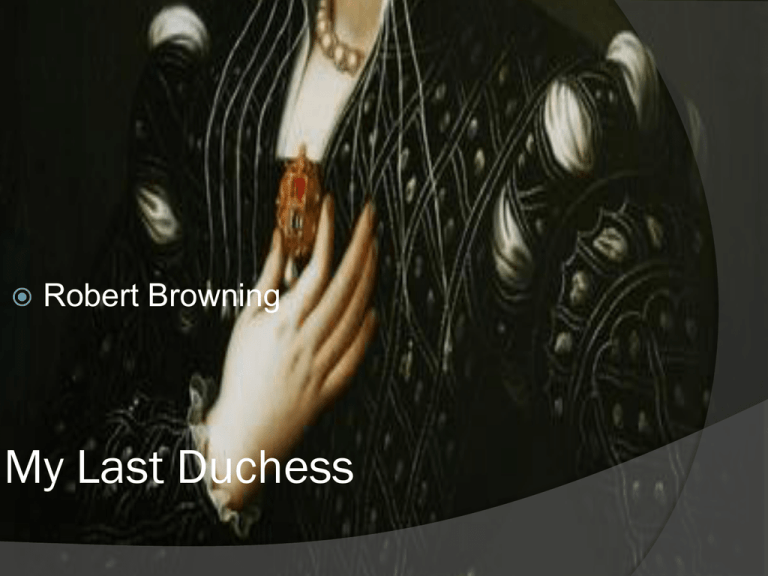
Robert Browning My Last Duchess Context of the poem Set in the 16th Century Italian Renaissance in Ferrara. The persona is based on the Duke of Ferrara, Alfonso II The object is an envoy sent by the Count of Tyrol to negotiate the Duke’s next marriage to his daughter Details: Browning first published poem under the title "I. Italy" in 1842 in Dramatic Lyrics, a collection of sixteen Browning poems. Browning changed the title of the poem to "My Last Duchess" before republishing it in 1849 in another collection, Dramatic Romances and Lyrics. Remember this fact. When you read the poem later think about the significance of the change in title. What difference would this make? Ferrara, Italy The Duke Fra Pandolf Artist Structure and form The poem is a dramatic monologue in which the character of the Duke is revealed 28 rhymed couplets of iambic pentameter – creating a controlled, regular beat in the poem The lines are using enjambment to create a driving force in the poem (through the lack of end-stopped lines), reflecting the Duke’s forceful personality. The enjambment also creates the natural tempo of a conversation The Duke interrupts the flow of his speech using questions and parenthetical comments showing his true nature and motivations breaking through the surface of his everyday language Structure and Language The elevated language is the Duke showing off his educated side: “that pictured countenance” (face) and, “your master’s known munificence” (generosity). These are two examples of his over-wordy speech Structurally, the fact that there are no stanza breaks and that the Count speaks uninterrupted for 56 lines points to a man who likes the sound of his own voice and is full of his own importance. The poem begins and ends with references to art and culture, emphasising the Duke’s civilised exterior. Themes Hubris The destructive nature of jealousy The objectification of women Art and culture used to create social status Hubris Excessive pride and arrogance – so much so that the relationship with reality is lost Hubris The Duke’s flaw, his arrogance, links to the way that he sees his treatment of the Duchess as justified. It also accounts for his apparent lack of judgement when speaking to the envoy. The Duke’s language conveys his hubris throughout the poem. The Duke’s sense of hubris comes from his aristocratic background, and is also shown in his choice of art and cultured items. The bronze statue shows his fantasy of mastering the natural world. The Duke clearly sees himself in the statue of Neptune. The destructive nature of jealousy The Duke’s jealousy causes the reader to become caught up in the psychological nature of the poem. The actions of the Duchess are never overtly evidence of infidelity, her guilt is confirmed in his mind. The Duke only allows himself to draw the curtain over the painting – showing his possessive and controlling nature. The objectification of women The last Duchess and the possible next Duchess are traded for money and social standing in the poem. The image of Neptune and the sea horse emphasises the way the Duke has objectified the Duchess by “taming” her and the power he has over her is conveyed by the statue. The painting is the final objectification of the Duchess – she literally becomes an objet d’art and the Duke has full control over her. Art and culture used to create social standing The Duke’s art collection marks him out as a Renaissance (meaning the rebirth of art, history, literature and science) The Duke’s cultured exterior and his aristocratic title masks his criminality. Art and culture of this type exclusive to the educated elite who controlled it in much the same way that the Duke controls the painting of the duchess. In this way, the Duchess can be seen to represent art and culture itself. Groups Group 1 – Anna, James, Shonie and Caroline (Objectification of women) Group 2 – Dionne, Nicole, Lauren and Keith (Hubris) Group 3 – Melanie, Sophie F, Lauren and Josh (The destructive nature of jealousy) Group 4 – Sophie M, Lisa, Danielle and Siobhan (Art and culture used to create social standing) Example “Nay, we’ll go/Together down, Sir!” As an aristocrat, the Duke could insist on walking ahead of the emissary, yet he makes this superficial egalitarian gesture. However the language reveals the Duke’s controlling nature as, despite the facade of politeness and etiquette -“Sir”, he is issuing commands to the emissary through the use of the imperative: “we’ll go” thereby emphasising his underlying domineering nature. Analysis Remember to fully explain what is said Relate it to the theme Explain how it is done (use of techniques) Essay Question 16. Choose a poem in which the tone is sinister or seductive or cynical. Show how the poem creates this tone and discuss its relative importance in your appreciation of the poem.
